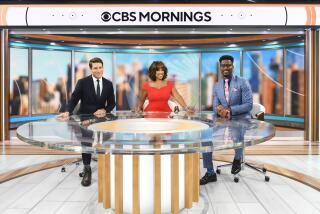ARCHITECTURE : CBS Building Manages to Make a Complex Design Seem Simple
- Share via
Good modern architecture--the abstracted, white and idealized kind--is a lot more complicated than it looks.
It has been reduced to the simplest materials and forms; to work, it has to be beautifully balanced. Each piece of the building has to do its job well because there are so few pieces.
An example is the CBS Building at 6121 Sunset Blvd., Hollywood. Though it is now painted a kind of dusty mauve, it was once a composition of nothing but right-angled white volumes. It had no monumental gateways like some of the movie studios, no fanciful Chinese pagodas or even Spanish Colonial touches to enliven its bare-boned structure. It managed to be a beautiful building just by the way it was composed--with both a simple appearance and complexity of design.
Designed in 1937 by William Lescaze, the East Coast “high priest of modernism,” and E. T. Heitschmidt, it represented a new type of building: a place for radio broadcasting that combined the forms of the warehouse-like movie studios of Hollywood and the modernist office buildings that were starting to dot cities’ downtowns. It had to house the abstract, ethereal and modern media of sound waves and give them a concrete image.
It is both an office building and a studio complex, and uses that fact to create a landscape of white walls and strip windows that recede, stand forward, go around corners and grab each other in the most minimal gestures. The main five-story office block is set perpendicular to the street, its function as a billboard made clear by a piece of the Western facade that has been pulled out into a kind of ear that supports the letters of the broadcasting company. Against that rather pristine block, Lescaze posed the various blank forms that contain the broadcast studios in such a way as to both define the street and create a small entrance drive. There are no static relationships between these forms: Windows go around corners, studios step up, and even fire stairs tumble down between shifting white planes.
Lescaze pushed and pulled form and function here. The studios form a solid base in the manner of a traditional European palace or government building, except that the ceremonial main floor has been shifted, removed from the base, and posed as an abstract office building. Originally, a wall split off from the southern edge of one of the studios and curved behind a row of columns holding up the offices. It then became a screen in front of the rear parking lot before merging into the other set of studios.
That link has since become a separate building, and the entry court has become a little courtyard separated from the street by a metal fence. It seems like a small gesture, as does the change in color, but what has been lost is the very essence of the building. Just by the placement of its forms, the CBS Building (now rather grandiosely called Columbia Square) was strong enough to both define the street and to create a new and separate realm. It stood out because the architect had taken the problem at hand, analyzed it, reduced it to its essentials, sketched those outlines in geometric white abstractions, and then underlined the salient characteristics of the building with lines that became windows, stairs and signs. Everything added after that has been, and always will be, superfluous.
More to Read
The biggest entertainment stories
Get our big stories about Hollywood, film, television, music, arts, culture and more right in your inbox as soon as they publish.
You may occasionally receive promotional content from the Los Angeles Times.










